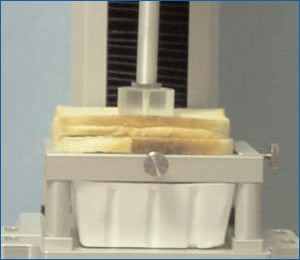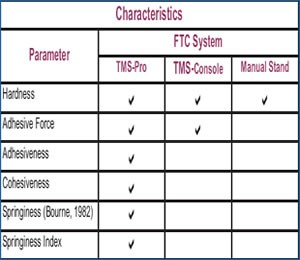Texture Analysis SolutionsBreadcrumb Texture Profile Analysis
Highlights
- Reproducible comprehensive texture profiling method applied to sliced bread over time
- Complex bite and chew simulation using a software-controlled texture analyzer
- Industry-standard compression probe applied compression and release for two repeats
- Quantified hardness, adhesiveness, cohesiveness and springiness texture attributes calculated to enable a complete analysis of product staling
Specification

A Texture profile analysis (TPA) compression method was used to measure the texture of commercial sliced bread over a three day period to quantify product staling.
A reproducible method was required for the practical assessment of breadcrumb texture as an indicator of product staleness. The method had to take into account a number of variables:
• formulation and composition
• environmental exposure and packaging
• location of the test site on the sample
• manufacturing process
• sample geometry
Method

The method used is based on a study at Campden and Chorleywood Food Association in 2002, investigating the standardisation of instrumental texture measurements in baked goods. The parameters of cohesiveness, hardness and springiness are used as reproducible predictors of breadcrumb texture.
Reproducibility was improved through critical selection of samples. Slices were critically selected to eliminate differentiation representative of differences in dough pieces and only slices located next to each other were used.
A second study was carried out 3 days later to represent the effect of staling within the sample. The first three slices were discarded to remove crust variation. Two samples were taken at a time.
Results
Texture Profile Analysis combines several attributes of a product, resulting in a wider overall evaluation of its texture (see glossary). Of those elements, three are particularly useful here:
- Cohesiveness - TPA when effectively applied can provide a reproducible measure of breadcrumb texture.
- Springiness - Instrumental analysis can be used in the optimisation of formulation, packaging and shelf-life.
- Hardness - Breadcrumb measurements can be used as a predictor of process behaviour, e.g., firmer textures may improve handling during slicing or automated sandwich manufacture.
Significance
Breadcrumb texture is a soft moist solid foam. When tested to small deformations (particularly when fresh), it exhibits extremely elastic characteristics. As it stales it exhibits a more viscous behaviour. The key parameters of cohesiveness and springiness reflect the development of internal bonding within the sample. Hardness is directly related to how hard or soft a sample feels. As the bread becomes staler it increases in hardness, reflecting a decrease in moisture content and an increase in bond strength within the rigid foam. The parameter of cohesiveness is more complex sensorially - it is correlated negatively to the rate of breakdown in the mouth and ease of separation in the hand. As bread becomes stale, moisture is lost and the bread is easier to separate in the hand and faster to breakdown in the mouth. The parameter of springiness decreases as shelf-life increases (staling progresses), due to an increase in the viscous element as the product ages.
